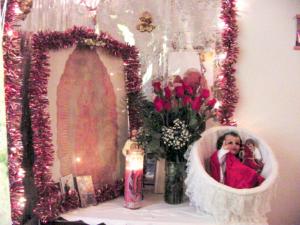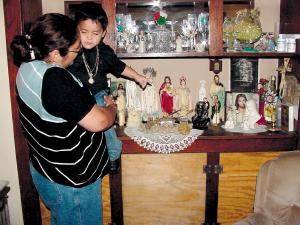Issue Date: November 14, 2003
Altars in Hispanic homes have a long and rich history that feminists and new immigrants in the U.S. are reclaiming By TERESA MALCOLM Altars in Hispanic homes testify to a centuries-old tradition that makes visible the link between the spiritual and the physical world. Combining crucifixes, statues of the Virgin Mary and saints with photos of family members who have passed away and objects associated with them, Hispanic home altars are about honoring family relationships and connecting the living with the dead, said scholar Lara Medina, assistant professor of Chicano and Chicano studies at California State University in Northridge. The popularity of home altars is undergoing a revival, Medina and other scholars say, driven by an influx of new immigrants from Latin America as well as the attention given them by Latina feminists, who see the home altar as a way a woman in a patriarchal culture “claims her authority to name the sacred,” as Medina puts it. Depending on the Latino group, home altars may feature images of the Sacred Heart, the Virgin of Guadalupe, St. Martin de Porres or the Virgin of Charity of Cobre (patroness of Cuba), said David Abalos, professor of religious studies and sociology at Seton Hall University in South Orange, N.J. “There is almost always a statue, candles around it, pictures of family, people who have died. It’s a family altar as well as the religious symbols and icons there,” he said. Medina observed that home altars function as sites of historical memory and teaching tools for families. “With photographs and meaningful objects, they teach family history,” she said. Abalos recalled songs and prayers around his family’s home altar when he was growing up. Singing and praying the rosary “binds the family together, binds them around a sacred message -- that all are important and valuable,” Abalos said. Alberto Pulido, director of ethnic studies at the University of San Diego, said that home altars, like other everyday expressions of spirituality, communicate the creator’s understanding of what it is to be in relationship with God and the sacred, in a “personal, practical and pragmatic” way.
Scholars say the Latino tradition of home altars has ancient roots. Indigenous groups such as the Maya, Toltec and Mexica created domestic altars to their deities. After the Spanish arrived in the Americas with their own predilection among the elite for elaborate home chapels, native people introduced Christian symbols to the home altars, reflecting the emerging syncretic nature of Mexican Catholicism, Medina said. “The icons that the Mestizo people developed incorporated Christian and indigenous elements in one object, such as a crucifix with the sun and moon placed on the cross, or a cross made out of corn husks,” she told NCR. “It was making the connection between the Christian deity and the sacred cosmic forces and the sacred food, corn.” With independence from Spain came curtailment of church authority in Mexico. The importance of domestic shrines correspondingly increased, said Medina. “The female prayer leader -- the rezadora -- became important because of the lack of priests. The elder women passed on the faith and the tradition of home altars. The institution was not really present, especially in rural areas.” Home altars were among numerous popular religious traditions that flourished among Mexicans in the area annexed by the United States in 1848. Encountering discrimination in the U.S. Catholic church and anti-Catholicism in the wider culture, “again, home and neighborhood remained central” for the faith of Mexican Catholics, Medina said. Domestic altars suffered a decline in the 1940s and ’50s, falling victim of the effort by the U.S. church to universalize Catholic worship -- that is, make it “Eurocentric,” according to Medina. The post-Second Vatican Council era continued the push to universalism. “A generation was under pressure to drop cultural traditions,” she said. “The home altar succumbed to the pressure.” Numerous families continued the tradition, Medina said, but with a different look. Her mother’s altar was “sanitized. Mary was in the middle, but it wasn’t Our Lady of Guadalupe, it was a European image of Mary. Mexican home altars are very eclectic and full of pictures and flowers and candles and other symbols, meaningful objects.” But in the United States, she said, the look was often “cleaned up.”
The tradition has been reclaimed, Medina said, with the emergence of Chicana feminist consciousness. “Contemporary generations recognize it as a subversive space that women have maintained and shaped on their own authority within a patriarchal culture and church. Altars provide a space for women to image and express ultimate meaning, which they’re not always able to in the traditional church,” she said. Medina noted the difference between a passive altar and an active altar. “A passive space you create one time and don’t interact with it. With active altars, there is interaction constantly. You add fresh flowers, candles, you sit at it, pray at it, talk about it, add to it, take things away. It’s prayerful action and it sanctifies the home. They’re a wonderful opportunity for the entire family to connect the spiritual world and the physical world,” she said. “Even if you’re not going through problems, bringing some kind of religious items into a space gives orientation to the world,” Pulido said. Practices such as praying the rosary every week at home in front of an altar with the Virgin of Guadalupe help people cope, he added.
Holidays such as the Day of the Dead (Nov. 2, All Souls Day) and Christmas are occasions to create special displays. Pulido recalled the elaborate nacimiento -- Nativity scene -- that his mother set up every Christmas. “I am always moved when I think about the creative agency and power of my mother as she methodically transformed part of our living room into a sacred space,” he wrote in an essay. “Through my mother, this creative artistic act defined for us who we were.” As the number of Latinos has grown in the church, there has been increasing effort by some priests to better understand traditions such as the domestic altar, Medina said. Workshops on altar making, especially around the Day of the Dead, are held in parish halls or community centers to transmit the tradition to younger generations. “Not everyone grows up with these traditions,” said Medina. “Some families have lost them. Many cultural workers are reclaiming the tradition and teaching people about them.” The creation of a sacred space within the home reinforces the importance of hospitality in Hispanic culture. “A visitor is from God,” Abalos said, explaining the well-known phrase, Mi casa es su casa (“My home is your home”). He added, “We believe the sacred permeates all our lives. We don’t separate the sacred and secular. Everything we do has sacred significance. The presence of the altar and prayers every day around that altar are reminders that the sacred is a part of our life every day of every week.” Teresa Malcolm is an NCR staff writer. Her e-mail address is tmalcolm@natcath.org National Catholic Reporter, November 14, 2003 |



